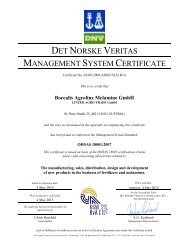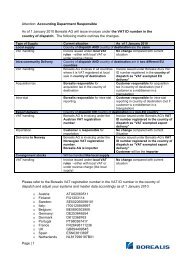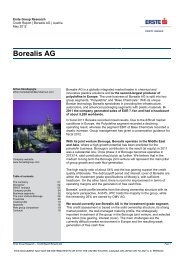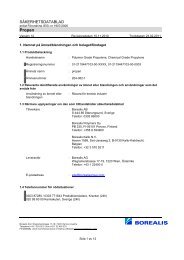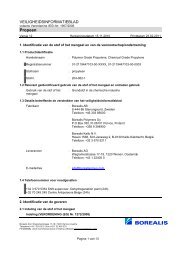Borealis AG Public Offering of up to EUR 200000000 Senior Fixed ...
Borealis AG Public Offering of up to EUR 200000000 Senior Fixed ...
Borealis AG Public Offering of up to EUR 200000000 Senior Fixed ...
Create successful ePaper yourself
Turn your PDF publications into a flip-book with our unique Google optimized e-Paper software.
junior <strong>to</strong> the other credi<strong>to</strong>rs' claims since the claims <strong>of</strong> the Noteholders in case <strong>of</strong> ordinary<br />
redemption are <strong>to</strong> be redeemed later than the claims <strong>of</strong> credi<strong>to</strong>rs under other financial<br />
instruments.<br />
2.3 Inves<strong>to</strong>rs in the Notes assume the risk that the credit spread <strong>of</strong> the Issuer widens and<br />
that as a consequence the price <strong>of</strong> the Notes falls (Credit Spread Risk)<br />
A credit spread is the margin payable by the Issuer <strong>to</strong> the holder <strong>of</strong> a Bond as a premium for<br />
the assumed credit risk. Credit spreads are <strong>of</strong>fered and sold as premiums on current risk-free<br />
interest rates or as discounts on the price.<br />
Fac<strong>to</strong>rs influencing the credit spread include, among other things, the creditworthiness <strong>of</strong> the<br />
Issuer, probability <strong>of</strong> default, recovery rate, the remaining term <strong>to</strong> maturity <strong>of</strong> the Notes, etc.<br />
The liquidity situation, the general level <strong>of</strong> interest rates, overall economic developments, and<br />
the currency, in which the relevant obligation is denominated may also have a positive or<br />
negative effect.<br />
Inves<strong>to</strong>rs are exposed <strong>to</strong> the risk that the credit spread <strong>of</strong> the Issuer widens resulting in a<br />
decrease in the price <strong>of</strong> the Notes.<br />
2.4 The inves<strong>to</strong>rs face a risk in case <strong>of</strong> an early redemption and in case <strong>of</strong> reinvestment<br />
(Risk <strong>of</strong> Early Redemption/Reinvestment Risk)<br />
In the event that the Notes are redeemed or being sold, an inves<strong>to</strong>r may be subject <strong>to</strong> the risk<br />
that he may not find any reinvestment opportunities at better or at least the same conditions.<br />
The same applies <strong>to</strong> the reinvestment <strong>of</strong> co<strong>up</strong>on payments derived from the investment. This<br />
could result in a material adverse effect for inves<strong>to</strong>rs.<br />
2.5 The Issuer may incur additional indebtedness ranking pari passu with the Notes<br />
The Issuer has not entered in<strong>to</strong> any restrictive covenants in connection with the issuance <strong>of</strong><br />
the Notes regarding its respective ability <strong>to</strong> incur additional indebtedness ranking pari passu<br />
with the obligations under or in connection with the Notes. Incurring any additional<br />
indebtedness may increase the likelihood <strong>of</strong> a deferral <strong>of</strong> co<strong>up</strong>on payments under the Notes<br />
and/or may reduce the amount recoverable by Noteholders in the event <strong>of</strong> insolvency or<br />
liquidation <strong>of</strong> the Issuer.<br />
2.6 <strong>Fixed</strong> rate securities are exposed <strong>to</strong> specific market risks (Market Price Risk)<br />
A holder <strong>of</strong> a note with a fixed interest rate is exposed <strong>to</strong> the risk that the price <strong>of</strong> such Bond<br />
falls as a result <strong>of</strong> changes in the market interest rate. While the nominal interest rate <strong>of</strong> a<br />
Bond with a fixed co<strong>up</strong>on is fixed during the life <strong>of</strong> such Bond, the current interest rate on the<br />
capital market (market interest rate) typically changes continuously. As the market interest rate<br />
changes, the price <strong>of</strong> such notes changes in the opposite direction. If the market interest rate<br />
increases, the price <strong>of</strong> such Bond typically falls, until the yield <strong>of</strong> such Bond is approximately<br />
equal <strong>to</strong> the market interest rate. If the market interest rate falls, the price <strong>of</strong> a Bond with a<br />
fixed interest rate typically increases, until the yield <strong>of</strong> such Bond is approximately equal <strong>to</strong> the<br />
market interest rate. Noteholders should be aware that movements <strong>of</strong> the market interest rate<br />
can adversely affect the price <strong>of</strong> the Notes and can lead <strong>to</strong> losses for the Noteholders if they<br />
42





